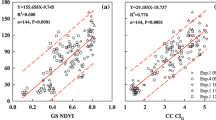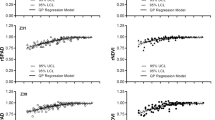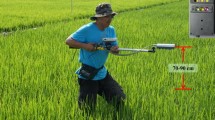Abstract
Fertilizing based on soil test and crop nitrogen (N) demand is the key to optimize yields and minimize fertilizer cost. In 2008, a field experiment with different N rates was conducted with early rice near Yingtan City, Jiangxi Province, in southern China. Canopy normalized difference vegetation index (NDVI) with an active sensor and plant N uptake (PNU) were collected at key fertilization stages; and the sufficiency index (SI) was calculated as the ratio of under-fertilized and well-fertilized NDVI. Rice PNU and yield were positively correlated with NDVI and SI at the tillering and panicle initiation stages. Canopy SI improved the PNU and yield estimations when the relationship was validated with a different dataset. A spectrally-determined N topdressing model (SDNT) was established and used in combination with a target yield strategy and split-fertilization scheme. An allocation coefficient for plant N requirement to accommodate the potential for high yield and soil N supply was introduced. Optimum nitrogen use efficiency (NUE) at different growth stages was incorporated into the model. The model was validated with data from a 2009 plot experiment and three production fields in 2010. The difference of recommended N rate and yield between SDNT and the current yield curve recommendation method was 2.1 and −0.7 % at high planting density and −2.4 and −4.8 % at low planting density, respectively. Compared with farmers’ N management, the SDNT strategy resulted in similar or higher yield with reduced N rates, higher NUE and higher net profit in both 2009 and 2010. Because canopy NDVI can be obtained while sidedressing N fertilizer in a single field pass, the potential of SDNT to accommodate within-field spatial and temporal variability in N availability should improve N management in rice.


Similar content being viewed by others
Abbreviations
- AEN:
-
Agronomic efficiency of applied nitrogen
- EONR:
-
Economic optimum N rate
- FN:
-
Farmer’s N management
- HD:
-
High density
- LD:
-
Low density
- MRE:
-
Mean relative error
- NDVI:
-
Normalized difference vegetation index
- NFOA:
-
Nitrogen fertilizer optimization algorithm
- NUE:
-
Nitrogen use efficiency
- PI:
-
Panicle initiation
- PNU:
-
Plant nitrogen uptake
- REN:
-
Recovery efficiency of applied N
- RMSE:
-
Root mean squared error
- SDNT:
-
Sensor-determined N topdressing model
- SI:
-
Sufficiency index
References
Allen, W. F. (1931). A micro-Kjeldahl method for nitrogen determination. Oil and Fat Industries, 8, 391–397.
Blackmer, T. M., & Schepers, J. S. (1996). Aerial photography to detect nitrogen stress in corn. Journal of Plant Physiology, 148, 440–444.
Broge, N. H., & Leblanc, E. (2000). Comparing predictive power and stability of broadband and hyperspectral vegetation indices for estimation of green leaf area index and canopy chlorophyll density. Remote Sensing of Environment, 76, 156–172.
Cassman, K. G., Peng, S., Olk, D. C., Ladha, J. K., Reichardt, W., Doberman, A., et al. (1998). Opportunities for increased nitrogen use efficiency from improved resource management in irrigated rice systems. Field Crops Research, 56, 7–38.
Clay, D. E., Kharel, T. P., Reese, C., Beck, D., Carlson, C. G., Clay, S. A., et al. (2012). Winter wheat crop reflectance and nitrogen sufficiency index values are influenced by nitrogen and water stress. Agronomy Journal, 104, 1612–1617.
Ding, Y. F., Liu, S. H., Wang, S. H., Wang, Q. S., Huang, P. S., & Ling, Q. H. (2004). Effects of the amount of basic and tillering nitrogen applied on absorption and utilization of nitrogen in rice. Acta Agronomica Sinica, 30, 739–744. (In Chinese with English abstract).
Dobermann, A., Witt, C., Abdulrachman, S., Gines, H. C., Nagarajan, R., Son, T. T., et al. (2002). Site-specific nutrient management for intensive rice cropping systems in Asia. Fields Crops Research, 74, 37–66.
Guo, J. H., Liu, X. J., Zhang, Y., Shen, J. L., Han, W. X., Zhang, W. F., et al. (2010). Significant acidification in major Chinese croplands. Science, 19, 1008–1010.
Hansen, P. M., & Schjoerring, J. K. (2003). Reflectance measurement of canopy biomass and nitrogen status in wheat crops using normalized difference vegetation indices and partial least squares regression. Remote Sensing of Environment, 86, 542–553.
Li, Q. K., Zhu, Z. L., & Yu, T. R. (1997). Fertilizer issues in the sustainable development of China agriculture (pp. 23–25). Nanchang: Jiangxi Science and Technology Press. (in Chinese).
Ling, Q. H., Zhang, H. C., Dai, Q. G., Ding, Y. F., Ling, L., Su, Z. F., et al. (2005). Study on precise and quantitative N application in rice. Scientia Agricultura Sinica, 38, 2457–2467. (In Chinese with English abstract).
Lukina, E. V., Freeman, K. W., Wynn, K. J., Thomason, W. E., Mullen, R. W., Klatt, A. R., et al. (2001). Nitrogen fertilization optimization algorithm based on in-season estimates of yield and plant nitrogen uptake. Journal of Plant Nutrition, 24, 885–898.
Massart, D. L., Vandeginste, B. G. M., Deming, S. M., Michotte, Y., & Kaufman, L. (1988). Chemometrics: A textbook. Amsterdam: Elsevier.
Nguyen, H. T., & Lee, B. (2006). Assessment of rice leaf growth and nitrogen status by hyperspectral canopy reflectance and partial least square regression. European Journal of Agronomy, 24, 349–356.
Ortiz-Monasterio, J. I., & Raun, W. R. (2007). Reduced nitrogen and improved farm income for irrigated spring wheat in the Yaqui Valley, Mexico, using sensor based nitrogen management. Journal of Agricultural Science, 145, 215–222.
Peng, S. B., Byresh, R. J., Huang, J. L., Yang, J. C., Zou, Y. B., Zhong, X. H., et al. (2006). Strategies for overcoming low agronomic nitrogen use efficiency in irrigated rice systems in China. Field Crops Research, 96, 37–47.
Raun, W. R., Solie, J. B., Johnson, G. V., Stone, M. L., Mullen, K. W., Freeman, K. W., et al. (2002). Improving nitrogen use efficiency in cereal grain production with optical sensing and variable rate application. Agronomy Journal, 94, 815–820.
Raun, W. R., Solie, J. B., Stone, M. L., Martin, K. L., Freeman, K. W., Mullen, R. W., et al. (2005). Optical sensor-based algorithm for crop nitrogen fertilization. Communications of Soil Science and Plant Analysis, 36, 2759–2781.
Roberts, D. C., Brorsen, B. W., Solie, J. B., & Raun, W. R. (2013). Is data needed from every field to determine in-season precision nitrogen recommendations in winter wheat? Precision Agriculture, 14, 245–269.
Schmidt, J. P., Dellinger, A. E., & Beegle, D. B. (2009). Nitrogen recommendations for corn: an on-the-go sensor compared with current recommendation methods. Agronomy Journal, 101, 916–924.
Schmidt, J. P., Beegle, D. B., Zhu, Q., & Sripada, R. (2011). Improving in-season nitrogen recommendations for maize using an active sensor. Field Crops Research, 120, 94–101.
Shi, P. F. (1998). Brief report of optimizing nitrogen fertilization on direct sowing early rice. Plant Nutrition and Fertilizer Science, 4(3), 319–320. (In Chinese with English abstract).
Singh, B., Sharma, R. K., Jat, M. L., & Martin, K. L. (2011). Assessment of the nitrogen management strategy using an optical sensor for irrigated wheat. Agronomy for Sustainable Development, 31, 589–603.
Tubana, B. S., Arnall, D. B., Walsh, O., Chung, B., Solie, J. B., Girma, K., et al. (2008). Adjusting midseason nitrogen rate using a sensor-based optimization algorithm to increase use efficiency in corn. Journal of Plant Nutrition, 31, 1393–1419.
Welsh, J. P., Wood, G. A., Godwin, R. J., Taylor, J. C., Earl, R., Blackmore, S., et al. (2003). Developing strategies for spatially variable nitrogen application in cereals, part II: Wheat. Biosystems Engineering, 84, 495–511.
Wood, G. A., Welsh, J. P., Godwin, R. J., Taylor, J. C., Earl, R., & Knight, S. M. (2003). Real-time measures of canopy size as a basis for spatially varying nitrogen applications to winter wheat sown at different seed rates. Biosystems Engineering, 84, 513–531.
Wu, W. G., Zhang, S. H., Zhao, J. J., Wu, G. C., Li, Z. F., & Xia, J. (2007). Nitrogen uptake, utilization and rice yield in the north of double-cropping rice region as affected by different nitrogen management strategies. Plant Nutrition and Fertilizer Science, 13(5), 757–764. (in Chinese with English abstract).
Xue, L. H., & Yang, L. Z. (2008). Recommendations for nitrogen fertilizer topdressing rates in rice using canopy reflectance spectra. Biosystems Engineering, 100, 524–534.
Xue, L. H., Cao, W. X., Luo, W. H., & Dai, T. B. (2004). Monitoring leaf nitrogen status in rice with canopy spectral reflectance. Agronomy Journal, 96, 135–142.
Xue, L. H., Qin, X., Li, G. H., & Yang, L. Z. (2010a). Effect of basal and tiller nitrogen rates on population dynamics, nitrogen uptake and utilization, and yield formation of direct-seeding early rice. Soil, 42, 681–688. (in Chinese with English abstract).
Xue, L. H., Yu, Y. L., & Yang, L. Z. (2010b). Nitrogen balance and environmental impact of paddy field under different N management methods in Taihu Lake region. Environmental Science, 32, 222–227. (In Chinese with English abstract).
Ling, Q. H. (2007). Theory and technology of precise and quantitative cultivation in rice (pp. 100–103). Beijing: China Agriculture Press. (in Chinese).
Zheng, Y. M., Ding, Y. F., Wang, Q. S., Li, G. H., Wang, H. Z., & Wang, S. H. (2008). Effect of nitrogen applied before transplanting on tillering and nitrogen utilization in rice. Acta Agronomica Sinica, 34, 513–519. (In Chinese with English abstract).
Zhou, B. (2007). Influence on yielding of nitrogen application of early season rice cultivation. Journal of Hebei Agricultural Sciences, 11(3), 14–20. (in Chinese with English abstract).
Acknowledgments
This work was partially supported by the National Natural Science Foundation (No. 40901104 and No. 41171235), and the Innovation Key Program of the Chinese Academy of Sciences (KZCX2-YW-QN406; KSCX1-YW-09-08).
Author information
Authors and Affiliations
Corresponding author
Rights and permissions
About this article
Cite this article
Xue, L., Li, G., Qin, X. et al. Topdressing nitrogen recommendation for early rice with an active sensor in south China. Precision Agric 15, 95–110 (2014). https://doi.org/10.1007/s11119-013-9326-5
Published:
Issue Date:
DOI: https://doi.org/10.1007/s11119-013-9326-5




